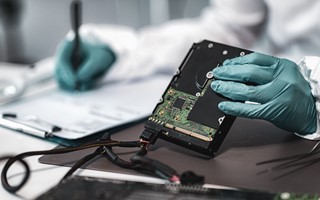Interviews June 18, 2020 11m
Interviewed by Olly Jarvis (Barrister, Crime author and founder of the Crime Hub) Forensic Access top expert, Philip Gilhooley takes the listener on a journey through the history of fingerprint forensics, famous cases and his own career.
Biography
With over 50 years’ experience in the field of fingerprint identification, Philip Gilhooley is an internationally recognised fingerprint expert.
He started his career with the Merseyside Police in 1964, qualifying as a nationally registered fingerprint expert in 1970, becoming Principal Fingerprint Officer, and Deputy Head of Bureau, in 1992. In April 2004, Phillip was promoted to Chief Fingerprint Officer, Head of the Merseyside Police Fingerprint Bureau.
From 2007 until 2011 he held the position of Senior Lecturer, Forensic Science at Liverpool John Moores University, and brought over forty years practical forensic experience to Academia.
He now works as an independent expert, for both prosecution and defence, and is frequently involved in reviews of cold cases, worldwide.
What is a fingerprint, and how is it left on the surface?
If people were to look at the skin on their fingers, palms and feet, they would notice that the skin on that part of the body is different from other parts. It’s made of friction ridges, which are furrows and ridges. These ridges aren’t continuous and a ridge can suddenly end or branch into two ridges. Along the edges of these ridges there are minute skin pores which emit sweat. When you touch a surface, an impression in sweat is left on that surface, which can be recovered.
A Fingerprint examiner looks at these characteristics on the finger and compares it against a crime mark. They look at the characteristics on both, and look for those that are the same and those that appear in the same sequence on both impressions. When satisfied they have found sufficient characteristics on both impressions, then identity is established.
So for court purposes, how many ridges do you need to see on a fingerprint?
Identification follows the clarity of the mark and the number of characteristics. Prior to 2001 in the UK we required 16 characteristics in agreement with none in disagreement. Or with two fingers, 10 in each.
In 2001 or the late 1990s, they decided that the number of sixteen points was picked out of the air. There was no statistical basis for wanting or requiring that number of characteristics. In 2001, England and Wales developed a system referred to as the non-numeric standard. This means that when a practitioner is analysing and comparing two impressions, once they have found sufficient number (which is a personal requirement) then they will be satisfied. They do not need to state how many characteristics have been found.
That’s the standard now. Let’s go back if we can, when was the value of this individual way of identifying people from their fingers first discovered?
I’ve always reflected on fingerpints and the identification process starting in India. When two people, Sir William Herschel and Sir Edward Henry, worked in India as Civil Servants. Herschel used the standard for fingerprinting identification for administrative purposes. He used to make people sign their contracts, their pension contracts mainly, so that they couldn’t be maliciously taken later in life. So he, at that time, recognised the importance of fingerprints for identification but not in the sense for identifying criminals.
So this time in India, what date are we speaking of?
So around 1845. The first criminal records in India were set up in the late 1800s. Sir Edward Henry, who was also a civil servant and inspector general in the police in India, maintained that this identification system could be used to identify criminals.
Sir Edward Henry came back to England in the early 1900s. He devised a coding system by which we could find fingerprints. In those days, all convicted criminals had to send a copy of their fingerprints to New Scotland Yard. They developed a large collection pretty quickly, so you have to have a coding system so you can search the fingerprints in a relatively small area of the database.
When was the first time this evidence was put forward in a trial in England?
In 1902, which was quickly after Sir Edward Henry started his system. There was a burglary in London where fingerprints were taken by the police from the crime scene examination and a man called Harry Jackson became a suspect. He was quickly identified by New Scotland Yard as the perpetrator by his fingerprints being found.
I think for a new system, the bravery of the people adopting a system like this so quickly is exceptional. Harry Jackson was sentenced for 7 years for his crime, which shows the pressure on expert witnesses at that time in a very new process of fingerprint identification.
I suppose there must have been a time when it was starting to be used in murder cases?
Yeah, very quickly. Three years later in 1905. The Stratton brothers in London were accused of assaulting and violently murdering two people in an office. They were called the Masked Murdered. One of the men left their fingerprints on a cashbox and was subsequently identified and the fingerprint evidence helped ensure the conviction was secure. They were hanged in Bedfordshire prison.
You started your career in the 1960s, a very different world back then in forensics. What made you enter this field?
I came into forensic work quite accidentally, yet quite fortunately. My aspirations were to join the police, though with my height this was never going to be an achieved ambition. I was just too short to join the police at that particular time.
If you weren’t 5’8 you couldn’t get in the police.
I was finally let down by a sergeant in the Liverpool police training school. I took a bus down to the employment people in the city centre. I’ll always remember the chaps name, Harry Cross. He said to me ‘we’ve just got three vacancies in for assistant fingerprint officers in Liverpool Police’. They were trying to release police officers back onto the streets and replace them with civilians to do the work in the offices. Three people were interviewed for the job, I got one of them. Here I am now, and I’ve never looked back!
When you started, one of the big cases in Liverpool which would have cast a shadow over your early career (though you hadn’t joined or were involved) was the famous case of James Hanratty. Of course, this was connected to the Liverpool area where you were working. Did this have an effect on your early life as a fingerprint analyst?
It did because afterwards, Sir Kenneth Oxford joined Liverpool, or Merseyside, Police as Deputy Chief Constable. Obviously when chief officers join police forces their case history is looked at. One of the cases he was always asked about was the James Hanratty case, the A6 murder. When Valerie Story was raped then shot five times, and Michael Gregson was shot dead. For many years, there were debates on whether James Hanratty was guilty or innocent. The police always maintained that the police identification evidence was fair.
Identification evidence is always under pressure in the CJS. Valerie Story gave a different version of her identification. She focused on his blue glaring eyes. She said she would never forget those eyes, and never wavered from that identification. This debate went on for many years.
In 2002 it was laid to rest when Hanratty and some of his relatives were exhumed, and DNA was extracted from Hanratty’s tooth. This was compared with DNA evidence from Valerie Story’s underwear and was found to be a complete match.
This is interesting because when you started out, Fingerprint evidence was the only forensic evidence there was. Now things have changed so much and there is often confirmation by other forms of analysis of those earlier convictions.
Yes, forensic evidence has been evolving since I started in 1964 up until the present day. I’m still analysing and examining forensic evidence from quite serious offences. Even I have noticed now the evolving forensic evidence.
It’s based really on Locard contact theory. Locard was a scientist who maintained that if a person went into a crime scene, they either put something in there in terms of their trace evidence or took something out. It’s been evolving so much. Now I do a lot of analysis and comparison of quite high-profile cases, and I notice that the evidence is becoming more and more forensic based. Obviously fingerprint evidence is still the best identity evidence you can give.
Lord Bichard in his inquiry after the Soham murders of Jessica Chapman and Holly Wells. He was asked by the government to create a report about some of the inadequacies of the evidence. He maintained several times that fingerprint identification is one of the most reliable identification evidence types to be used in criminal trials.
One of the questions I’m sure that you are asked more than any other, is how long can a fingerprint impression remain on a surface?
I get asked this question so much, especially by Barristers in Court, and quite often the judge themselves. The answer is ‘how long is a piece of string’?
Fingerprints once deposited on a surface by somebody, can in theory last forever. Obviously, the reliability of it relies on the environment that it is in. If it is outside and is open to the elements and things, it can be washed off quite quickly. It depends on whether the article the print is on has been washed or been subject to any other environmental issue that could have destroyed it. One of the things about aging of fingerprints is that it is scientifically impossible to age them. You cannot identify when and how they were left.
I’ll give you an example of how long they can be left. I was instructed by the national media museum in Bradford to do a review on some fingerprints which were left by Niépce. He was a French inventor who was credited with inventing the first photographs in the world. He used chemicals to develop these photographs, and I was at the Bradford Museum when they disclosed the plates that had been protected for many, many years. Niépce developed these plates in the 1700s.
I investigated these plates. The fingerprints were on the edges of the plate and could only be left by Niépce himself. So 250 years and they weren’t destroyed by environmental issues.
You’ve been involved in hundreds if not thousands of cases over the years, all of which must have left their mark on you in some ways. Is there one case above all others that has affected you?
The one that sticks out in my memory is the Helen McCourt case. Helen was an insurance agent who worked for an insurance company in Liverpool. One night in February 1988 she phoned her mother to say she would be home from work and could she have her tea ready so she could go out with her boyfriend that night. It was a horribly windy night in February, and she didn’t arrive back home as she was due. Her mother became very anxious.
The next day the police thought that this wasn’t just a missing person case, and that something had happened to her. Soon afterwards they approached the manager of the George and Dragon pub, in Billinge, and he was quickly arrested as a witness. They examined his car and quickly realized he had something to do with the disappearance.
The next day I, with a team of forensic officers, entered the George and Dragon Public House. For many days, and it went on into weeks, we examined this property for trace evidence that could help identify the offender. By the end of the case we had developed lots of forensic evidence from his car. We found blood and an earing in the boot of his car. The earing was positively identified as a 21st birthday present of the victim. The thing we look for is two-way contact. We wanted to show that Helen had been in the George and Dragon, and that she brought evidence out of the George and Dragon.
At the side door at the public house, there appeared to be evidence of blood and a physical assault. At the door of the pub I found a fingerprint in blood. We found fibres from upstairs in the room. In the back bedroom we conducted a fingertip search, which is so important in forensic searches, and we found the backing of an earring.
When the case was heard it was suggested that he assaulted Helen at the bottom of the stairs, dragged her up and strangled her upstairs with an electrical wire. Then dragged the body into the rear bedroom where we found the clip of the back of the earring. There were all sorts of fibre evidence. We found on the cable that we believed was used for strangulation there were teeth marks from the dog.
So as you can see, we had blood evidence, fibres, and contact evidence, and the two-way transfer was firmly established. I gave evidence in the trial where the defendant alleged that the blood was on the door prior to him touching it, and thus he left a fingerprint on it. I spent many hours in the witness box showing that the blood was on his finger when he touched the door rather than as he suggested. It was accepted. The defendant is due for release, and Helen’s mother is having a law passed (called Helen’s Law) that will hopefully stop people being released from prison who wont admit their guilt or show where the body was. Helen’s body still hasn’t been found, after many, many years.
The mother has been denied the right of burying her daughter.
The case that you’ve just described how all the different strands of forensic evidence work together. Of course, going back to when you started it was just fingerprint evidence. Now there’s fibres, there’s DNA and all sorts of different methods. Does Fingerprint testing still have a place in crime detection?
Yes. If it didn’t I would be out of work reviewing cases! Many times, even now in high profile cases I deal with, drug offences, firearms offences, murders, fingerprint evidence still plays a part.
Fingerprints are still identified in numerous cases by the police. It’s also a cheap and effective way of solving crimes. The police have their fingerprint bureau’s there, they don’t have to spend money on it. They just submit the fingerprints into the bureau and the bureau search for them on a national fingerprint identification system called ‘NAFIS’. Which is fairly new itself, it’s only in recent years that this has been accepted as a tool to identify fingerprints. People get the impression that it identifies them, it doesn’t.
What an IDENT1 from the National Fingerprint Identification System does is, based on the appearance of the characteristics (the ridge ends etc I spoke of early), will plot those characteristics on the crime scene mark and it will be investigated on the computer and it will supply a list of candidates which have features that are in the same area. It provides a list of around 30 applicants which the fingerprint officer still has to go through and identify each one.
Philip Gilhooley, thank you very much for speaking to the Crime Hub.
To find out more about our Fingerprint services offered by Forensic Access fill-in our online contact form or Tel: 01235 774870 to speak with our team.


